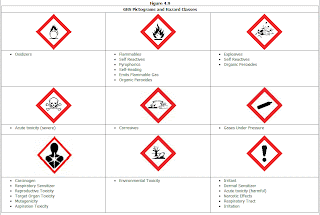This material would be shipped with this DOT/IATA label:
Under the GHS classification system, an "organic peroxide" is defined as:
 |
| Source |
Easy.
Now let's look at how the new GHS labeling system conveys the hazard of a container of organic peroxide Type D shipped in a box:
 |
| Source |
Which, for our material, the manufacturer identifies all the required information as follows:
If an organic peroxide is a chemical substance that may undergo "exothermic self-accelerating decomposition" shouldn't that little bit of important information be the first thing the person picking up the product understands about the stuff in the container?
The GHS pictogram for an organic peroxide is:
That's the same pictogram used by DOT to describe a flammable liquid, flammable solid, dangerous when wet, spontaneous combustible, and an organic peroxide.
 |
| Source |
Only DOT uses color and a number to differentiate between the different hazards.
I wish I would have recognized this earlier. Here is what I recommend as a fix:
Scrap the GHS pictograms and use a DOT label - including color - in its place for those hazards where a DOT Class 1 through Class 8 label is currently in place.
Why?
Because DOTs system of warning = color, symbol, and number - is easy to understand and it works.
Don't believe me? Try this experiment. Show the following labeled and ask the person to tell you what the hazard is of the material inside.
I'll bet at least 8 out of 10 get it right.
DOT labels work because they communicate the hazard and can be easily taught and understood.
.









